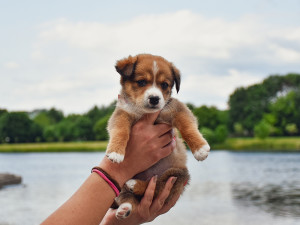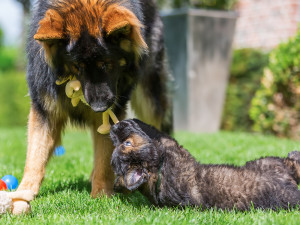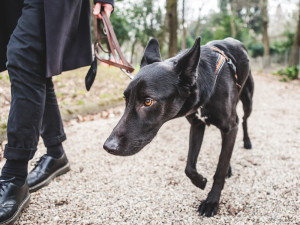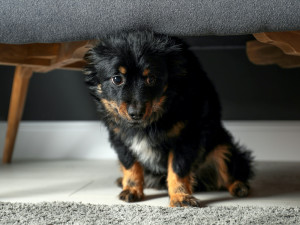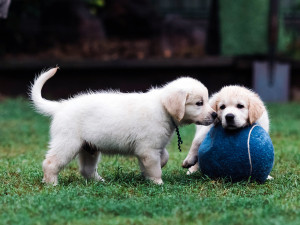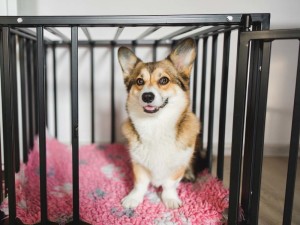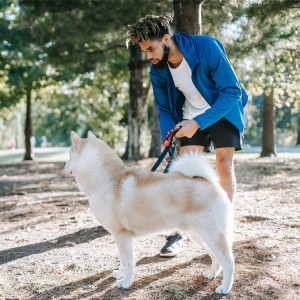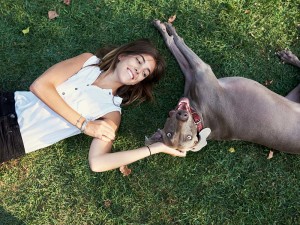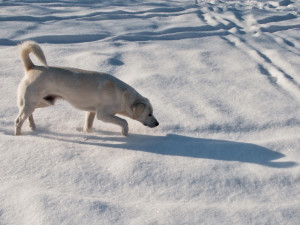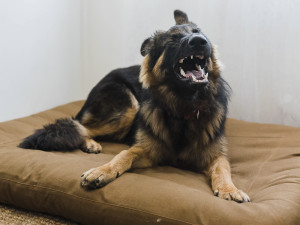How Do I Get My Shy Dog To Socialise?
Dog trainer Robert Haussmann’s tips for getting a shy pup to go from wallflower to social butterfly
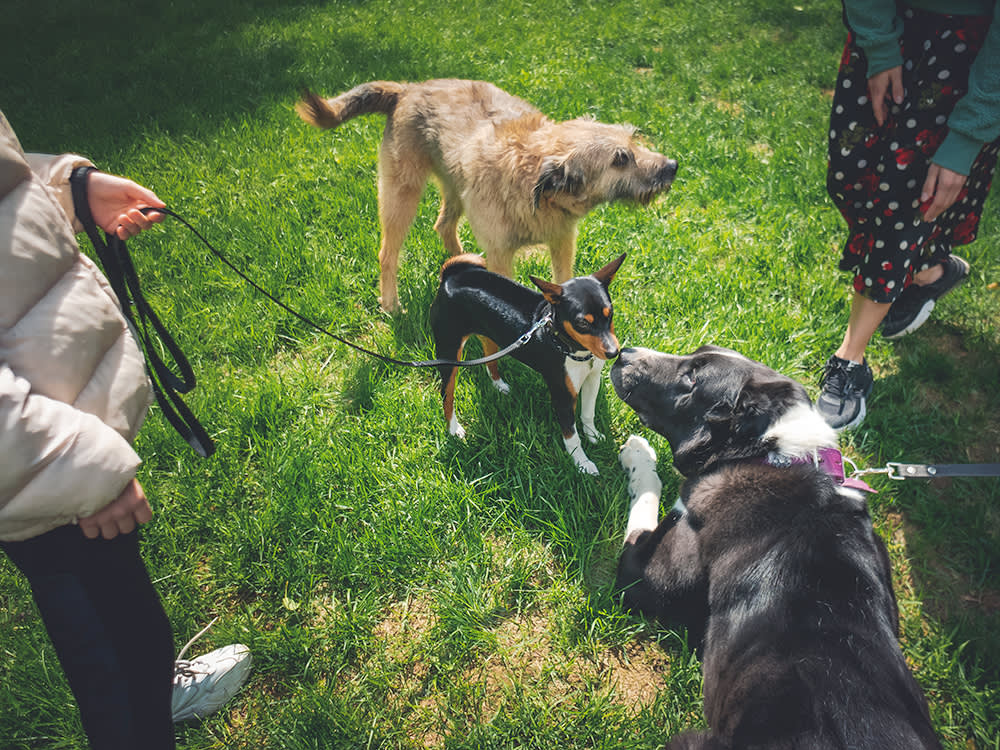
share article
When you first bring home a puppy, your priorities might go like this: get in the maximum number of cuddles, make sure they get those puppy naps in and keep them from chewing every single item in your home. You might not be thinking about another very important part of puppy development: socialisation.
Just as it’s good for babies to meet other babies – even if all they do is stare at each other – puppies need to see and interact with other dogs. So, in addition to the oodles of cuddles on your priority list, make sure you add a social hour or two to your pup’s weekly schedule.
Why is socialisation important for my fearful dog?
I have a six-month-old named Gator who is a very shy puppy; he is a velcro dog and never leaves my side. He’s generally pretty happy, but he lived in the mountains for the first couple of months of his life, so isn’t used to hanging out with other dogs. At the park, he doesn’t play with other dogs unless they approach him first. How can you socialise a nervous dog?
Being a bit cautious isn’t necessarily a bad thing. But perhaps we can help improve his comfort level and willingness to engage other dogs. We also want to prevent him from becoming over-stressed and developing any fearful or reactive behaviours around other dogs.
Dogs go through a developmental stageopens in a new tab known as the critical period – commonly referred to as the socialisation period – between 2–14 weeks of age. During this time, dogs can develop familiarity with a variety of sights, sounds, other animals, people and situations. It is their exposure during this crucial time that builds resilience and confidence around novelty. The more exposure, the more comfortable they become. Because Gator has spent much of his early socialisation period in the mountains, he may not have developed his social chops with other dogs. This can leave him feeling unsure about inviting or accepting play and/or expressing his likes and dislikes and his ability to safely resolve conflict.
At six months of age, Gator is just starting his teen yearsopens in a new tab. Along with the awkwardness that befalls all teens, dogs also hit yet another developmental phase called the secondary fear period. The secondary fear period starts between 6–8 months of age and lasts until about 18 months. This lesser-known and often overlooked stage of life coincides with the time when a dog would leave the care of his mother and venture off into the world. Nature, being as clever as she is, flips a little switch in the brain that says, be careful, if you’re not 100 percent sure, stay back and proceed with caution!
Having a sheltered early socialisation period followed by intense exposure during the secondary fear period can lead to anything from minor discomfort to severe fearfulness depending on the dog. Lucky for you, it sounds like Gator is more of the former and just feels a bit uncomfortable around other dogs. Here are some tips to help him go from wallflower to social butterfly.
How can I tell if my dog is shy or fearful?
Here are some of the most common signs of an unsocialised dog:
A fearful dog might have flattened ears, lick their lips, yawn, cower, avoid eye contact or tuck their tail between their legs when around strangers or other dogs
A shy dog might exhibit aggressive behaviour, such as staring, erect ears, barking a lot, snarling or growling and snapping when around strangers or other dogs
A shy or fearful dog might back up, raise their hackles, or exhibit aggressive behaviour when on walks even if no one else is around.
How do I start socialising my shy dog?
Start small
Parks with lots of dogs, doggie daycaresopens in a new tab and playdates with other rowdy puppies may be a bit too much for Gator. Closed spaces with larger groups of dogs running around and playing can often be pretty overwhelming. To introduce a nervous dog to other dogs, try enlisting some friends or family membersopens in a new tab with dogs to go on walks together, moving in the same direction and having the chance to be near each other without a lot of face-to-face encounters right away. Allow both dogs to take their time and feel safe. They are seeing and smelling each other from a distance while roaming around together sniffing and exploring.
After about 10 minutes of this, you can stop and see if they are interested in sniffing each other for a few seconds. Once they have given a sniff or two, walk on for a bit longer, stopping occasionally to assess their comfort level and allow them to engage in prosocial behaviour. They can then be encouraged to have a little outdoor off-lead play too. Building Gator’s social experience and exposure should accumulate into an overall sense of safety in the presence of dogs.
What are some socialisation techniques for shy dogs?
Find your tribe
Some dogs play rough, some dogs play gently. Some dogs like to chase, some dogs like to wrestle. Others just want to play fetch and be left alone. When you’re trying to teach your dog to greet other dogs calmly, follow Gator’s lead on what kind of player he is and set him up with playmates and activities he enjoys.
Perhaps the park on a Saturday morning is just too rowdy for him. Maybe the closest park is just not big enough for him to find a buffer to create space and assess the situation. Maybe he is more into an open field with a few good friends. If you find a group of dogs he gets on with, try and make it a regular thing. If you find a big open park where he can avoid rowdy dogs and find more chill playmates, go out of your way to take the trip – even if it means passing the park right around the corner.
Help him build confidence
To help build confidence in your insecure or shy dog, engaging in activities where Gator can feel capable and safe can help him in his day-to-day confidence. Try engaging in some scent games. Have him perform a down stay in one room while you hide his breakfast, a few bits of dry dog food here, a few bits there, then release him to go find it. If he eats wet or raw food this can be distributed in stuffable rubber toys and hidden in the same manner.
Speaking of stuffable toys, invest in a variety of interactive feeding toys that he can engage with and dissect. This can be the primary way he eats his meals and any snacks outside of training. Having him search and forage for his own food is a great way to help him feel capable.
Book a class
A well-run group training classopens in a new tab can be an organised way to train a timid dog by engaging with other dogs without play being the primary focus. Find a dog socialisation training class with a professionally certified trainer who practices LIMA (Least Intrusive, Minimally Aversive) techniques and has plenty of experience. Learning a strong foundation of training cues is also a real confidence booster and opens up a clear line of communication and a strong bond between you and Gator.
What if my shy dog shows signs of distress during socialisation?
While it will be tempting to take him into the park on a Saturday when everyone looks like they are having a good time, try to avoid putting him in situations where he may feel overwhelmed. You may even receive well-meaning advice to keep bringing him until he gets used to it. But this can have adverse effects on your progress, especially during this sensitive time in his development. Exposure to dogs is critical to getting him to feel more confident around them and therefore more social. Make sure to work slowly until he is ready and excited to go play.
Once Gator is more comfortable playing with dogs, it is still important to know when he has had enough or if he is feeling a bit overwhelmed. Familiarise yourself with canine body language and the subtle cues that indicate when he is and is not comfortable. Remember you are his teacher, guardian and overall main squeeze. He depends on you for information and trusts you to make decisions that keep his best interests in mind.
Frequently asked questions
Should I force my shy dog into social situations?
Definitely not! Ease your shy dog into social situations by enlisting the help of some friends or family members with dogs to go on walks together.
Is professional training necessary for socialising my shy dog?
A well-run group training class run by a certified trainer can be an organised way to train a timid dog by engaging with other dogs without play being the primary focus.
How long does it take for a shy dog to become more socialised?
It really depends on the dog and why they are so shy – it can take anywhere from a few weeks to months.
Can I use calming supplements or medications to help my shy dog socialise?
Keep track of what triggers your dog’s fears and relay that to your vet so they can help you figure out if supplements or medications might help.
References:
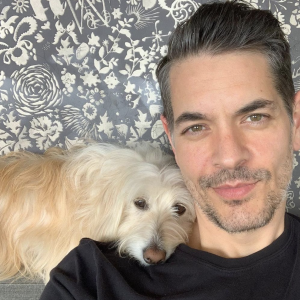
Robert Haussmann, CPDT-KA
Robert Haussman founded Dogboy NYC in 2005 to help pets navigate the urban jungle that is New York City using creative, practical, and humane training methods. Haussmann is a Certified Professional Dog Trainer and Canine Behavior Consultant, specializing in helping dogs overcome behavioral issues including fear, phobias, anxiety, and aggression. He advises owners on the best practices for making their dogs feel safe at home and beyond.
Related articles
![Smiling Welsh Corgi Pembroke dog sitting inside an open crate]() opens in a new tab
opens in a new tabHow to Crate Train a Puppy
Effective techniques to crate train your dog with ease
![man unleashing dog in a park]() opens in a new tab
opens in a new tab6 Steps to Improve Your Dog’s Recall Training
Teach your pup a perfect recall so you can be sure they will come back, no matter what
![Shy black dog walking with owner at the park.]() opens in a new tab
opens in a new tabHow to Help an Anxious Dog Conquer Their Fears
Six animal behaviourists share pro tips for boosting the confidence of a fearful dog
![Woman laying on the grass smiling at her dog]() opens in a new tab
opens in a new tab10 Ways to Make Your Dog’s Life Better
Number six will probably surprise you
![Dog looking at their shadow in the snow]() opens in a new tab
opens in a new tab“Why Is My Dog Obsessed With Chasing Shadows?”
A fascination with lights and shadows is common in high-energy dogs – but it can develop into obsessive-compulsive disorder if it gets out of hand
- opens in a new tab
Reverse Sneezing in Dogs: Causes and Treatment
Don’t panic: it’s called reverse sneezing, and in most cases, it’s nothing to worry about
